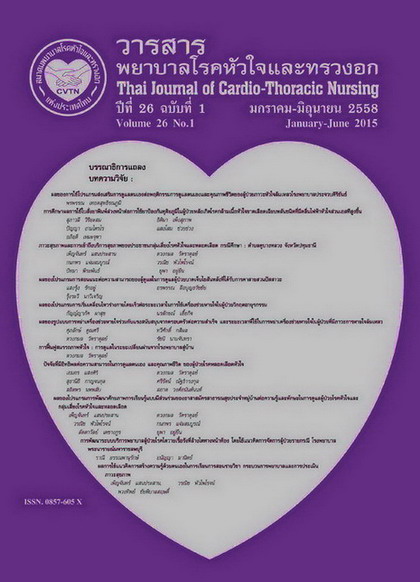การฟื้นฟูสมรรถภาพหัวใจ : การดูแลในระยะเปลี่ยนผ่านจากโรงพยาบาลสู่บ้าน
Keywords:
การฟื้นฟูสมรรถภาพหัวใจ, ทฤษฎีเปลี่ยนผ่าน, ผู้ป่วยโรคหัวใจและหลอดเลือด, cardiac rehabilitation, transition care, patients with cardiovascular diseaseAbstract
ผู้ป่วยโรคหัวใจและหลอดเลือดควรได้รับการดูแลอย่างต่อเนื่องตั้งแต่ระยะเฉียบพลันในโรงพยาบาลจนกระทั่งจำหน่ายออกจากโรงพยาบาล การฟื้นฟูสมรรถภาพหัวใจเป็นการดูแลที่ครอบคลุมไปถึงให้การช่วยเหลือผู้ป่วยและครอบครัวให้สามารถเผชิญกับความเจ็บป่วยและความยากลำบากของสถานการณ์ที่เปลี่ยนแปลงในชีวิต พยาบาลมีบทบาทสำคัญในการฟื้นฟูสมรรถภาพหัวใจเพื่อให้ผู้ป่วยและครอบครัวสามารถจัดการกับความ เจ็บป่วยและเปลี่ยนผ่านการดูแลจากโรงพยาบาลไปสู่บ้านอย่างปลอดภัย
วัตถุประสงค์ของบทความนี้ คือ การสังเคราะห์การพยาบาลในระยะเปลี่ยนผ่านโดยการบูรณาการทฤษฎีเปลี่ยนผ่านกับโปรแกรมการฟื้นฟูสมรรถภาพหัวใจ ซึ่งพยาบาลผู้จัดการรายกรณีมีบทบาทสำคัญ ในการดูแลระยะเปลี่ยนผ่าน ที่ประกอบด้วย 3 ขั้นตอน คือ ขั้นตอนที่ 1 การประเมินความพร้อมของผู้ป่วยโรคหัวใจและหลอดเลือดในการเปลี่ยนผ่าน ขั้นตอนที่ 2 การเตรียมความพร้อมด้านร่างกายและจิตใจให้แก่ผู้ป่วยเพื่อเปลี่ยนผ่านการดูแลจากโรงพยาบาลสู่บ้านโดยการวางแผนการจำหน่ายผู้ป่วยอย่างมีประสิทธิภาพร่วมกับการบูรณาการองค์ประกอบสำคัญของการฟื้นฟูสมรรถภาพหัวใจระยะที่ 1 และขั้นตอนที่ 3 การพยาบาลในบทบาทเสริมเพื่อสนับสนุนการเปลี่ยนแปลงบทบาทใหม่และคงไว้ซึ่งผลลัพธ์สุขภาพทั้งร่างกายจิตใจและคุณภาพชีวิตที่ดี ด้วยการบูรณาการการฟื้นฟูสมรรถภาพหัวใจระยะที่ 2, 3 และ 4 ให้คงไว้พฤติกรรมการจัดการตนเองเพื่อสุขภาพหัวใจที่ดีอย่างยั่งยืนในระยะยาว ได้แก่ การประเมินผู้ป่วย การให้คำปรึกษาด้านโภชนาการ การจัดการกับปัจจัยเสี่ยง การฝึกการออกกำลังกาย การจัดการดูแลด้านจิตสังคม การให้คำปรึกษาการออกกำลังกายและการฝึกออกกำลังกาย ซึ่งในแต่ละองค์ประกอบจะต้องมีการประเมินผล (evaluation) การดำเนินการ (intervention) กำหนดผลลัพธ์ที่คาดหวัง (expected outcome)
พยาบาลผู้เชี่ยวชาญโรคหัวใจและหลอดเลือดควรได้รับการอบรมในหลักสูตรการพยาบาลเฉพาะทาง เพื่อเพิ่มสมรรถนะด้านการฟื้นฟูสมรรถภาพหัวใจบนพื้นฐานทฤษฎีการเปลี่ยนผ่าน เพื่อดำเนินการพัฒนาโปรแกรมการฟื้นฟูสมรรถภาพหัวใจในสถานบริการทุกระดับ มีการประเมินผลลัพธ์และตรวจสอบการประกันคุณภาพเพื่อให้ผู้ป่วยโรคหัวใจและหลอดเลือดเข้าถึงบริการอย่างมีคุณภาพและต่อเนื่อง
Cardiac Rehabilitation : Transition care from hospital to home
The patients with cardiocascular disease (CVD) should be continuously cared from acute phase at hospitals until discharged by providing cardiac rehabilitation. Cardiac rehabilitation should be included with support patients and families to cope with disease and difficulty in altered situation of their lives. Nurses should engage to assist patients and families in dealing with their particular health/illness and provide care during the transition from hospital to home with safety.
The objective of this article is to synthesize transition nursing therapeutic by integrating the theory of transition nursing with cardiac rehabilitation. The nurse case managers play important roles in three stages. The first stage, nurses should assess for readiness of patients with CVD in transition phase. The second stage, nurses should prepare patients’ physical and psychological to promote transition care from hospital to home by providing effective discharge planning integrated with core component of the first phase of cardiac rehabilitation. The third stage, nurses play supplementation role to promote patients to change new roles and to maintain good physical and psychological outcomes as well as better quality of life. Nurses should use supplementation role to incorporate with cardiac rehabilitation phase 2, 3 to 4 to maintain sustainable self management of healthy health behavior constantly including evaluation, interventions, and expected outcomes in each of the core components such as baseline patient assessment, nutritional counseling, risk factor management, psychosocial interventions, and physical activity counseling as well as exercise training.
Cardiovascular nurses should be prepared and be trained for advanced nursing course to enhance competency of cardiac rehabilitation based on transition care theory. Cardiac rehabilitation program should be developed in all level of health care settings with outcome evaluation and quality assurance in order to promote patients with CVD to access quality of care persistently.
Downloads
How to Cite
Issue
Section
License
บทความนี้ยังไม่เคยตีพิมพ์หรืออยู่ในระหว่างส่งไปตีพิมพ์ในวารสารอื่น ๆ มาก่อน และกองบรรณาธิการขอสงวนสิทธิ์ในการตรวจทาน และแก้ไขต้นฉบับตามเกณฑ์ของวารสาร ในกรณีที่เรื่องของท่านได้ได้รับการตีพิมพ์ในวารสารฉบับนี้ถือว่าเป็น ลิขสิทธิ์ของวารสารพยาบาลโรคหัวใจและทรวงอก






